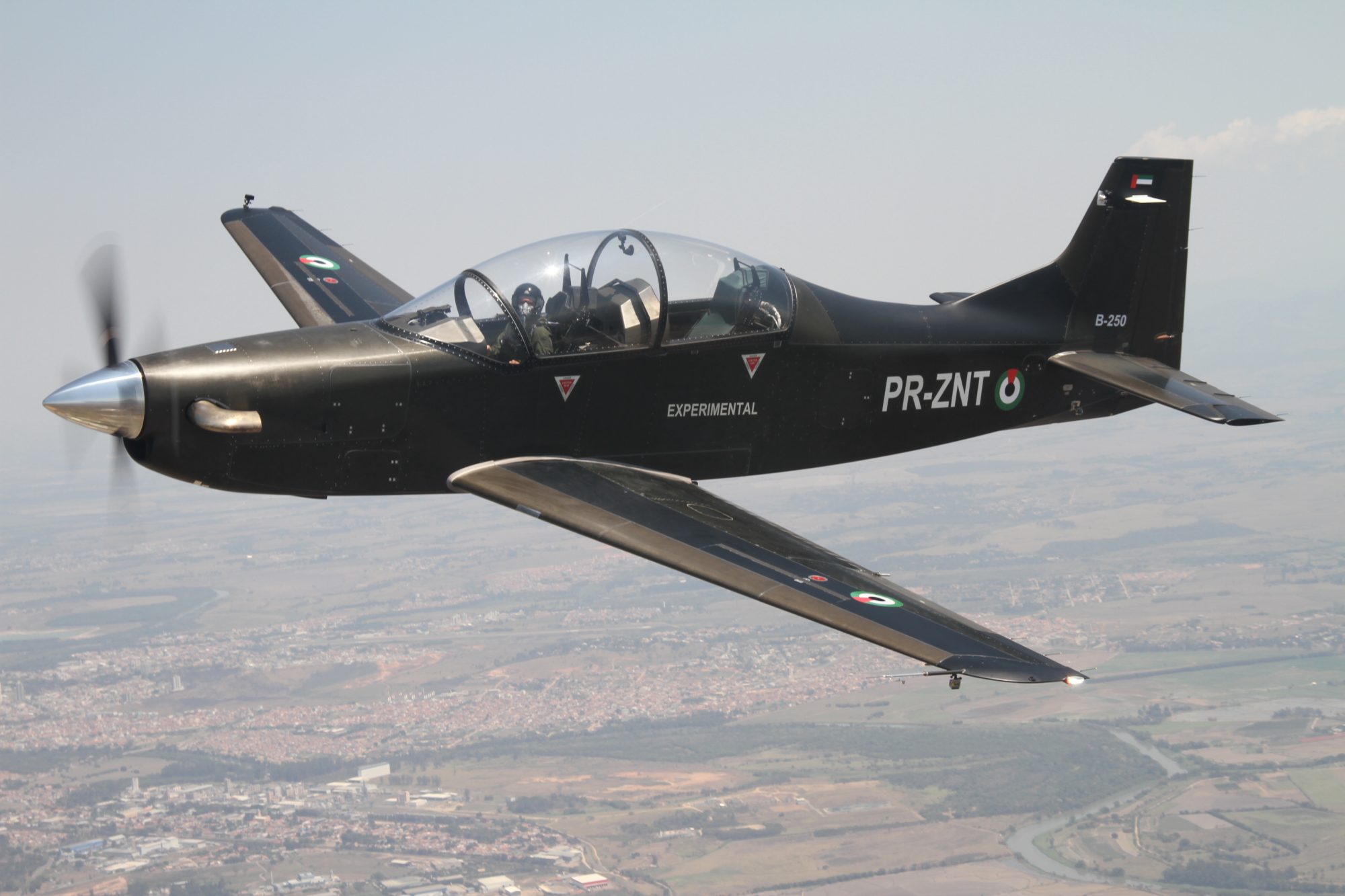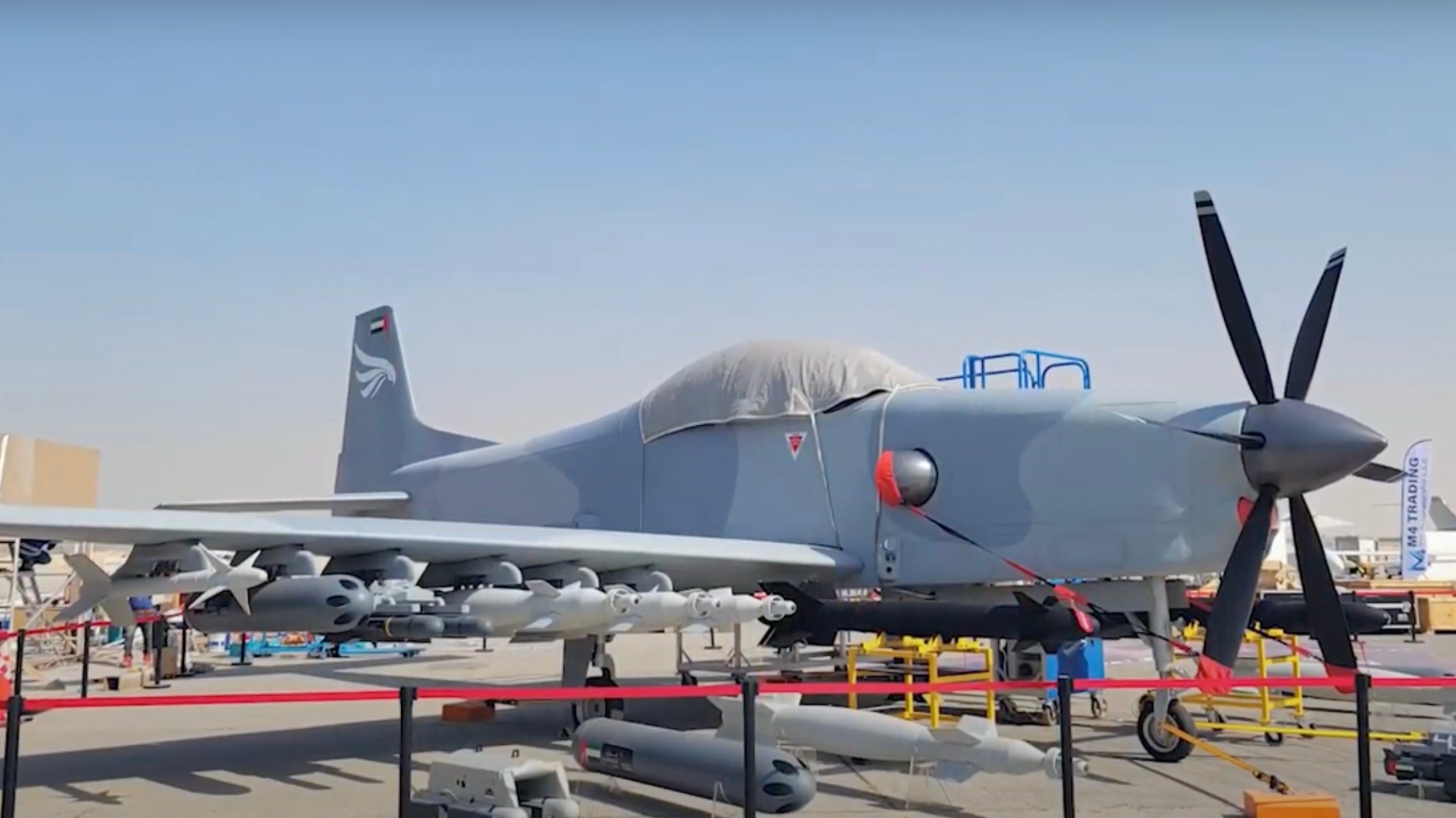The appearance of an all-new military aircraft design is a fairly rare occurrence these days, but rarer still when the aircraft in question belongs to a new category in terms of mission spectrum, size, and performance. The Calidus B-350, which broke cover in mock-up form at the ongoing Dubai Airshow, fits this bill: A new offering from the Abu Dhabi-based company, the aircraft is a relatively enormous single-engine turboprop attack platform, broadly akin to a Douglas A-1 Skyraider albeit thoroughly updated for the 21st century.
Making a surprise appearance at the exhibition, the two-seat B-350 looks at first sight fairly similar to other turboprop offerings in the light attack category, such as the Embraer A-29 Super Tucano that’s being evaluated by U.S. Air Force Special Operations Command, or AFSOC. The difference, though, is the huge size of the B-350.
Its proportions are very deceiving until you put a human being next to it and you realize it is a bizarre monster of an aircraft:
While that much is clear from a cursory examination of the mock-up, the limited detailed information that has crept out about the B-350 thus far comes mainly from CHARVÁT AXL, a Czech company that has signed a contract to deliver landing gear sets for the aircraft. An in-house publication reveals some data relating to the B-350, including a wingspan stretching more than 50 feet and a maximum takeoff weight of around 20,000 pounds. By way of contrast, the A-29 has a wingspan of just over 36 and a half feet and a maximum takeoff weight of just under 12,000 pounds. By this measure, the slab-sided B-350 is a true beast — a ‘mecha Tucano,’ if you like.

The B-350 really appears much closer in size and ambition to the Cold War-era Skyraider that served with distinction with the U.S. Navy in Korea, with the U.S. Air Force and Navy in Vietnam, and with a variety of other operators in combat duty around the world. The A-1 also had a 50-foot wingspan, while its maximum takeoff weight was a little over 18,000 pounds.

The Emirati aircraft is powered by a 2,600-horsepower Pratt & Whitney Canada PW127, the same unit that’s used in the ATR 72 twin-turboprop regional airliner and the Airbus C295M military transport. The aircraft will reportedly be built mainly using carbon-fiber composites.

All this size and power translates to a considerable load-carrying capability, with a wide range of weapons and sensors that can be lugged on no fewer than 12 underwing hardpoints, some of which can accommodate dual launchers. Stores options include precision-guided air-to-ground missiles and bombs and infrared-guided air-to-air missiles — as well as various sensors for intelligence, surveillance, and reconnaissance (ISR) and targeting. The mock-up was shown alongside an array of possible ordnance, including Al-Tariq bomb kits produced by the UAE’s Edge company.
Images of the B-350 appear in the first half of the following video:

Additional stores, including a large multi-sensor targeting/surveillance turret, and radar/electronic warfare pods, can be carried on further stations below the fuselage. It’s also possible that the B-350 may be especially suitable for certain niche roles, such as anti-helicopter missions, which would require gun pods or lightweight air-to-air missiles.
The B-350 is a follow-on to the Calidus B-250, which was unveiled at the Dubai Airshow in 2017 and is a turboprop trainer and light attack aircraft of much more conventional proportions. Powered by a 1,600-horsepower Pratt & Whitney Canada PT6A-68, the B-250 was designed by Novaer, a Brazilian company that was headed up by the late Joseph Kovács, who had designed the original Tucano for Embraer. The first two B-250s were built in Brazil before being shipped to the UAE. Not surprisingly, perhaps, the B-250 has much in common with the Tucano/Super Tucano in terms of form and function.

At the 2019 edition of the airshow, the United Arab Emirates placed a $620-million order for 24 B-250s, an air force spokesperson telling reporters that “it’s a UAE platform for the UAE.”
However, the status of the B-250 order remains unclear, with the UAE Air Force currently relying on a mixed fleet of German Grob G 115 and Swiss PC-7 and PC-21 turboprop trainers. In the meantime, Calidus has also announced a more advanced version of the trainer, the B-250T, which offers new features including a mission-recording and debriefing system, and optional simulated radar and weapons.
Intriguingly, there were unconfirmed rumors back in 2019 that the B-250 design had already been judged unsatisfactory, and AirForces Monthly reported on “speculation that ongoing development will probably see a bigger, more suitable aircraft being developed […] called the B-350.”
Regardless of its relationship to the B-250 order, the B-350 might still attract domestic interest anyway, as the UAE continues to develop its Joint Aviation Command (JAC), a separate flying branch that’s dedicated to counterinsurgency and tackling other asymmetric threats. Currently, the JAC operates the fixed-wing IOMAX Archangel close air support and ISR aircraft, based on the Thrush S2R-660 crop-duster, and which you can read more about here. These serve alongside Cessna 208s and Twin Otters, as well as various rotorcraft, including AH-64 Apache attack helicopters.

The B-350 may therefore have been tailored as a follow-on to the Archangel, offering expanded performance, endurance, and weapons carriage. Compared to the B-350, the Archangel has just six underwing hardpoints, plus one on the centerline, as well as a maximum takeoff weight of 14,800 pounds. The IOMAX design is not fast, with the manufacturer advertising a cruising speed of 180 knots, with undisclosed stores.
Calidus may also be hopeful of securing export orders for the big turboprop, perhaps from operators that require something more than an A-29 or an AT-6 Wolverine, but which still prize the low operating costs, short-field performance, and ruggedness of a turboprop. The A-29, in particular, has been enormously successful in carving out a niche for itself in the turboprop counterinsurgency/light attack segment, winning orders from customers across Latin America, Africa, the Middle East, and elsewhere in Asia, with some of these customers having taken it into combat.

This marketplace is also increasingly occupied by drones, although there is still a broader requirement for manned aircraft that benefit from what humans in the cockpit bring to counterinsurgency and close air support scenarios in terms of situational awareness. Furthermore, combat-capable unmanned aircraft generally remain a higher-end option, with significant demands in terms of infrastructure and training. The costs involved also mean that a manned platform is often a far more accessible path to fielding an airborne counterinsurgency and lower-end close air support capability. Manned and unmanned platforms are usually most effective in these roles when paired together.
With that in mind, Asian or African nations engaged in this type of warfare might be tempted to look at the Calidus design, providing that they don’t face a significant threat from hostile air defenses, against which even a high-flying B-350 would be potentially vulnerable. That said, the B-350 does at least appear to have provision for some kind of self-protection suite, with mountings for missile approach warning sensors visible on the fuselage, and launchers for infrared flares would seem likely, at the very least.

Bearing in mind the increase in performance and payload, and potentially loiter time, over existing light attack platforms, the B-350 might instead find itself facing competition from ‘medium’ attack aircraft such as the Sierra Nevada Corporation MC-145B Wily Coyote. On the other hand, the Emirati design is unique as a heavy single-turboprop design optimized for this kind of work.
A potential point in favor of B-350 exports is that the aircraft will likely be free of systems covered by the U.S.-imposed International Traffic in Arms Regulation (ITAR) framework, under which the U.S. Department of State can restrict exports to certain countries. The B-250 was developed to be ITAR-free, and the same will probably be the case for the B-350, hence the locally made munitions on display alongside the mock-up.
However, the manufacturer has so far remained tight-lipped about either internal requirements or export prospects, and we really don’t know how far this project has progressed, beyond the mock-up on show in Dubai.
According to CHARVÁT AXL, that company signed a contract, apparently in 2020, to deliver landing gear kits for three flying prototypes of the B-350 within three years, with the first set to be delivered within 18 months.
If that’s the case, we might not have to wait long to see a real B-350, by which time Calidus will hopefully have revealed more about its plans for this intriguing giant.
Contact the author: thomas@thedrive.com
